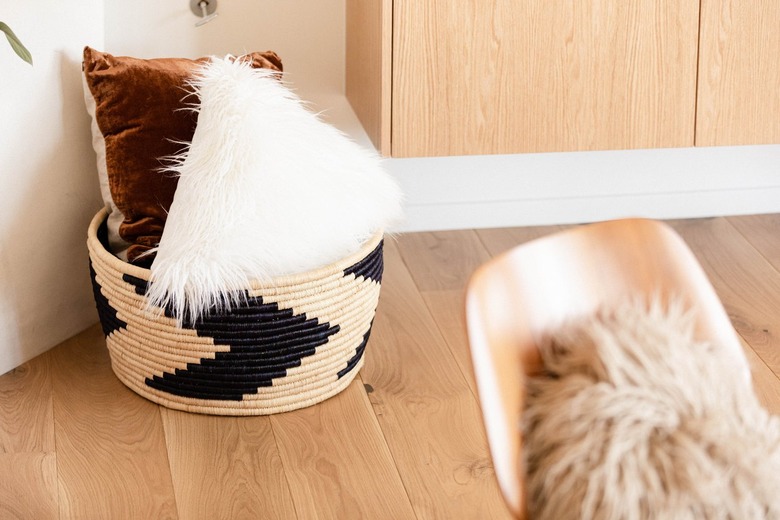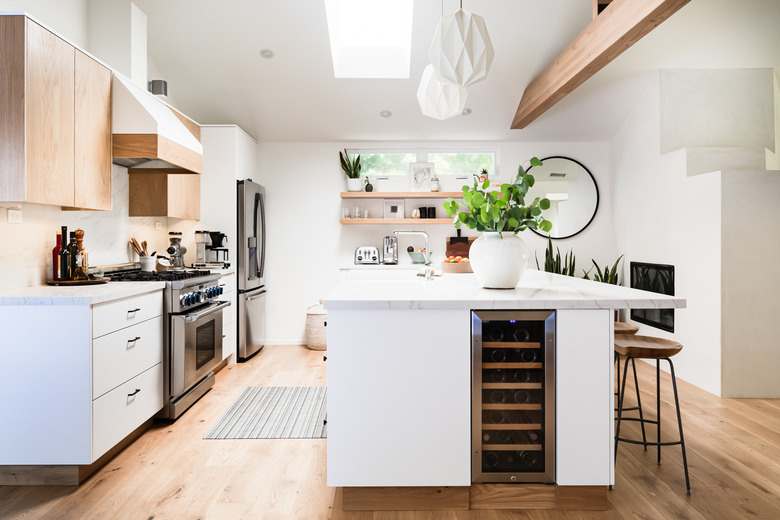White Oak Flooring: A Homeowner's Guide
There's a reason white oak hardwood flooring is one of the most popular hardwood flooring options: It's sustainable, easy to work with, resistant to water, attractive and reasonably affordable. There are many species that make up the white oak group of trees, and lumber made from these trees comes in a variety of grades and can be cut in a number of different manners, meaning the appearance of white oak flooring can vary drastically from one floor to another.
About White Oak
About White Oak
White oak is a popular tree throughout North America and is so beloved that it has been named the state tree of Connecticut, Illinois, Iowa and Maryland. As the Wood Database explains, Connecticut's state quarter was even minted with an image of a white oak. White oaks grow across the U.S., although the majority of white oaks used for commercial purposes are grown in the eastern U.S., according to Purdue University. Its abundance means it is both sustainable and reasonably affordable.
It's worth mentioning that while there is one particular species of tree commonly called white oak (Quercus alba), when most people talk about white oak, they are talking about a broad group of trees labeled as white oaks. The majority of oak trees native to North America can be classified as either white or red oak, with a smaller number fitting in the live oak group. As a result, there is a bit of variation in white oak and red oak flooring planks based on the species from which they are made. There are some general characteristics that define one species as part of the white oak or red oak groups, though.
White oak wood can be a little more expensive than red oak (white oak is around $3 to $5 per square foot, whereas red oak is anywhere from $2 to $5 per square foot), it has a major benefit in that its less-porous nature makes it resistant to rot, whereas red oak is particularly susceptible to water damage.
Choosing between the two based solely on appearance can be difficult since they look quite similar, particularly if they have already been stained, but red oak tends to have a slight pink tinge and white oak tends to be a bit darker with more golden tones. However, with the wide variety of red and white oak species, shades can vary significantly, and some white oaks even have pink hues.
White Oak Grain Pattern
White Oak Grain Pattern
White oak planks feature alternating layers of coarse and fine textures, and the pores of the wood are filled with outgrowths that help protect the wood from damage — which is precisely what makes white oak resistant to rot caused by water damage. Because of these outgrowths, the grain pattern in white oak is coarse and uneven compared to some other woods but a lot more fine than that found in red oak.
The way oak flooring is cut can drastically enhance or reduce its grain pattern.
- Plain sawn: Most wood planks, including those for hardwood
flooring, are cut plain sawn since it is the most inexpensive way to cut logs. The
result leaves fanning patterns of the grains, resulting in the roughest and
most distinctive grain pattern. - Rift sawn: This choice is best for those who want to minimize the appearance of
the grains, as this option has the tightest grain
pattern, resulting in a largely uniform pattern. Because this method produces
the most waste, it is the most expensive. - Quartersawn: These hardwood flooring planks are cut at a
degree in between that used for plain-sawn or rift-sawn planks. They don't have
quite the rough appearance of plain-sawn wood, but they instead have dramatic
flecking going across the grain, which is particularly attractive in white oak
flooring.
Benefits of White Oak Hardwood Flooring
Benefits of White Oak Hardwood Flooring
White oak flooring offers many benefits over other woods, particularly red oak. White oak hardwood flooring is slightly harder than red oak while still being soft enough to be easily workable.
On the Janka wood hardness scale, the maximum score is over 4,000, at which point wood is incredibly difficult to plane, sand, nail or otherwise use for building purposes. Red oak, ranked 1,290, is considered the best to plane and the second best to bore. With a hardness of 1,360, white oak is still easy enough to use for hardwood flooring, but it adds an extra 70 points of hardness, making it more resistant to denting and more suitable for homes with kids and pets.
While red oak absorbs stain well because of its open pores, the slight pink tones can give strange results when using light stain colors such as gray or whitewash. For these shades, it's better to stick with white oak hardwood flooring, which can be stained easily but stays truer to the intended shade. Additionally, the even grains of white oak can render more consistent color results.
White Oak Flooring Options
White Oak Flooring Options
White oak flooring comes in two options: prefinished and unfinished. Prefinished planks are stained already so you can see what color you will end up with and save time avoiding DIY work. However, unfinished planks are less expensive, and staining them yourself gives more color options.
Whether or not you stain your floor, you should add a finish, and white oak flooring takes well to matte, semi-matte, semigloss and high gloss. Remember to select your finish based on the installation area for your white oak hardwood flooring, as high gloss wears faster than other options.
Another characteristic buyers need to consider is the width of their planks. Standard-width planks are usually between 2 and 4 inches wide, whereas wide planks are anywhere from 5 to 12 inches wide. Wide planks show off more of the wood grain patterns and can create a more open feel in a room, but they are more expensive and may have more knots and imperfections.
Quality Options for White Oak
Quality Options for White Oak
Oak flooring comes in both engineered and solid hardwood options. Solid hardwood flooring tends to have more longevity since it can be refinished numerous times, whereas engineered hardwood floors can only be refinished a few times.
When choosing white oak solid hardwood flooring, there are four quality grades available:
- Prime grade: The highest quality, these planks are cut from
the center of the log, resulting in few knots, little sap and uniform
appearance with minimal color variation. - Select grade: The next step down from prime, these boards
have some knots, some sap and some color
variation but not too much. - Natural grade: These boards have more knots than select and in
larger sizes. The planks also have more sap and more color variation. Some
manufacturers will add a colored wood filler to fill in holes to give it a
smoother appearance. - Character grade: Also called rustic grade, this is the
lowest-quality option. It has a lot of color variation, sap and knots that are
often large enough to require filling. While these boards are not considered
prime, many people actively seek them out for the traditional vintage look.
Engineered hardwood only features a thin layer of oak wood with an inexpensive hardwood core. Engineered hardwood is less expensive, and some products can be installed easily to make floating floors by virtue of their click-lock design. Solid hardwood is more expensive and always needs to be installed with nails. Whichever you choose, you're soon to have a gorgeous room.
References
- The Wood Database: White Oak
- The Wood Database: Distinguishing Red and White Oak
- Purdue University: White Oak
- BuildDirect: What is White Oak Hardwood Flooring?
- Hardwood Distributor's Association: What Is the Difference Between Quarter Sawn, Rift Sawn and Plain Sawn Lumber?
- The Flooring Girl: 7 Advantages of White Oak Hardwood Flooring
- Fine Homebuilding: Red Oak vs. White Oak: Key Differences
- State Symbols USA: State Trees
- ImproveNet: How Much Does it Cost to Install Hardwood Floors?



